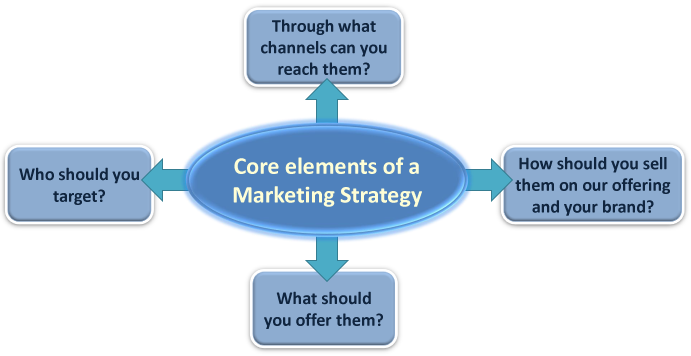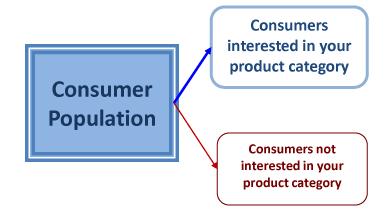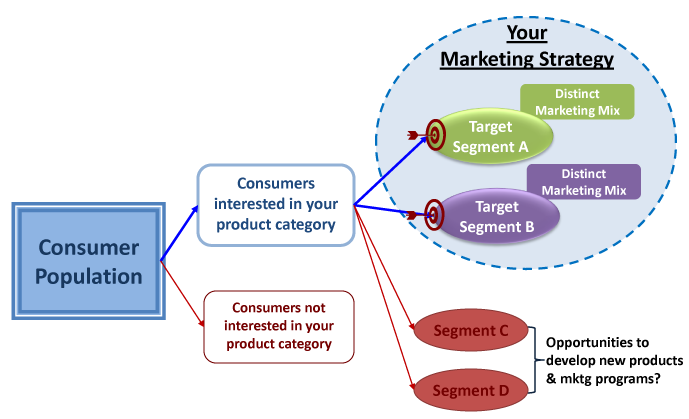I've found this framework to be immensely helpful to me throughout my career. Particularly during those fire-fighting, short-term focused periods of work that we all experience from time to time, this framework has always helped me to reorient myself & recalibrate.
Strategic Marketing Framework to print out & hang on your wall at work
at 1:43 PM 1 comments Labels: framework, marketing, marketing strategy
Using segmentation to develop your marketing strategy
While there are many ways to harness the power of segmentation, one of the broadest and most valuable applications is for designing your marketing strategy – a strategy that clearly defines who you’re targeting, what you’re going to offer them, where you’re going to reach them, and how you’re going to sell them on your product & brand.
Segmentation for designing marketing strategies is a 2-step jig
Step 1: Identify “the who”
Step 2: Identify your target segments
The second step is where things really get cooking. In step 2 you take the population of interested consumers and group them based upon their similarities with respect to “the what, why, where & how” of your product category.
In this step your goal is to identify the most attractive segments for your business to target – segments for which the following are true:
- One or more of your products meet the segment’s functional & emotional needs
- Your existing channels for selling, servicing & awareness-building align with the segment’s channel preferences and media-consumption habits
- Your product & brand positioning align with the segment’s “reasons for buying” from both a functional and emotional perspective
- You can identify the segment in a cost-effective manner
- The segment is large enough in size and profit-potential to merit investment in a distinct marketing mix
- Are interested in one of more of your products
- Are most effectively targeted using a distinct marketing mix
- AND, are large enough to merit your investment in this distinct marketing mix
These segments will become your target segments and along with their distinct marketing mixes represent your marketing strategy. To reiterate from the intro, the beauty of this approach is that by basing part of your segmentation on similarities shared by consumers across key components of your marketing mix, the segments you derive come with their “marketing instructions” already included.
What about segments you choose not to target?
So what about segments that don’t meet enough of your targeting criteria? What should you do about them? The answer is that it depends.
For those segments large enough in size & profit potential you may consider developing new products, building out new channels, or creating communication strategies that better meet their needs and more effectively “speak to them”.
On the other hand, for those segments that are very small or that would require major retooling of your operations, extensive employee training, or significant stretching of your brand, you would likely leave to other companies to pursue.

More posts on segmentation & marketing strategy:
- What is customer segmentation?
- Segmentation and targeting
- Using the 5 W's to inform segmentation & marketing strategy
- Strategic Marketing Framework to hang on your wall
Great books & articles on segmentation:
- Making Segmentation work (PDF)
- Market Segmentation: How to do it, how to profit from it
- Counterintuitive Marketing: Achieve Great Results Using Uncommon Sense (One of the best general marketing books with a terrific chapter on segmentation
Snapshot of some of my favorite business books
So I was in my office today and my Droid was nudging me to take a quick snapshot of a stunning view of some of my favorite business books... it's so hard to say no to a Droid...

----------
at 7:22 PM 0 comments Labels: business books
Search Engine Optimization for Dummies and Dummy-Impersonators
This post is for those of you who see the acronym SEO and feel your throat tighten, your palms begin to sweat, and think to yourself, "ughhh, I know we need this SEO stuff for or to our website, I only wish I knew what SEO stood for!.." (And no, you're far from a dummy if you find SEO confusing - I used this title purely to help my Google page rank for this post ;)
No matter how confused you ever become about Search Engine Optimization, if you remember the following you will always be able to reorient yourself and make a quick "recovery":
Google is just a librarian...
Think of Google as the head librarian of our 21st century digital library - a library filled with all the world's websites, including yours.
Google's job is simply to provide its patrons (i.e., users of its search engine) with the best information on the topics they are searching for, usually provided in the form of website links, images or videos.
 For example, let's say a nice, eligible bachelor named Larry wants to find out what he can do to "tame" his fiery dragon breath and make it past date #1. Larry comes up to the library counter (i.e., www.google.com) and asks Google for information about Halitosis. Google, at lightning speed, runs to the Halitosis section of the "library", and grabs ALL of the websites on Halitosis. When Google returns to the counter, she places all of the Halitosis sites in front of Larry, sorting them from most relevant & most popular to least relevant & least popular.
For example, let's say a nice, eligible bachelor named Larry wants to find out what he can do to "tame" his fiery dragon breath and make it past date #1. Larry comes up to the library counter (i.e., www.google.com) and asks Google for information about Halitosis. Google, at lightning speed, runs to the Halitosis section of the "library", and grabs ALL of the websites on Halitosis. When Google returns to the counter, she places all of the Halitosis sites in front of Larry, sorting them from most relevant & most popular to least relevant & least popular.That is Google's search engine in a nutshell. (And yes, it was recently revealed by the company that Google's search engine is in fact female)
...SEO is simply good book labeling
So how does SEO come into play within this "digital library" of all the world's websites?
Think of SEO as the process of effectively labeling & categorizing your website so that Google understands what your site is about and therefore knows when to include it as part of a person's search results.
Going back to our Halitosis example, imagine there are 2 websites on the topic of bad breath. Site A's name is, "How to Eliminate Bad Breath", and site B's is, "Fighting the Enemy One Brush at a Time".
The main sections of site A (think titles of book chapters) include definitively breath-related headings like "Where bad breath comes from", "Top tips for beating Halitosis" and "Why brushing alone won't prevent bad breath". In contrast, the main sections of site B include somewhat vague, albeit more humorous headings such as, "Readying for battle", "Exorcising your tongue", and "The war within".
Which of these 2 websites do you think Google would rank higher on the list of Halitosis sites it returns to our eligible, yet breath-challenged bachelor? Unfortunately it's not the site with the more creative copywriter. Sorry.
Google's no poet, so easy on the metaphors
While Google is one heck of a librarian, she's not a mind reader - at least not yet. In other words, you need to be extremely clear and literal with your website content, especially when it comes to major headings & titles.
Think of it this way - if you're thumbing through a book trying to figure out what it's about, you're most likely going to look at the book's cover, leaflets, chapter names, and index. Google ""thumbs through" your website in much the same way. So cute and overly metaphoric titles like "Making it to date #2" will only help drag your site's Google ranking down... and with it, your website traffic.
Now that you hopefully have a better 50,000-foot view of SEO, below are a few resources that I've found to be particularly insightful for SEO newbies.
Additional SEO sources for beginners looking to get a little dirt on their hands
- Search Engine Optimization: An Hour a Day (solid book that teaches you the core principles & tactics)
- SEO Moz - beginners guide (SEO Moz is one of the best all-around SEO sites)
"Would you like a coke with your product-sandwich?"
How many times have you been asked the above question at your local wine store? "Huh?" you say.... okay, so maybe you weren't asked the question explicitly... instead it was embedded in the array of differently priced wines displayed throughout the shop.
"Huh?" you say.... okay, so maybe you weren't asked the question explicitly... instead it was embedded in the array of differently priced wines displayed throughout the shop.
For those of you who, like me, know little about wine, when was the last time you went into a wine store and bought the cheapest wine on the shelf? When was the last time you bought the most expensive wine on the shelf? My guess is that most of you can't recall the last time you did either because when you go to the wine store you "play it safe" and usually buy a wine priced "somewhere in the middle". I know I do.
Little did you realize that your local wine store was employing a product-sandwich strategy, drawing you helplessly towards that mid-priced bottle of wine! And you thought you were in control! :)
What is a Product-Sandwich Strategy?
In a nutshell, the strategy involves creating/selling a (very) high-priced version of your product so that the next price down appears more moderate in comparison. Often times this "next price down" would be considered expensive by the customer in absolute terms, but in relative terms (i.e., next to your "Rolls Royce" model) it appears reasonably priced. If implemented successfully, the net impact on your business is a boon in sales of the mid-priced version.
Why does the Product-Sandwich Strategy work?
The Product-Sandwich strategy is based on the principle that when buying an unfamiliar product or service people tend to purchase a mid-priced version of it. Why? It all comes down to risk aversion - fear of making a bad purchase and flushing money down the toilet bowl. This toilet-bowl-infused aversion is the reason we shy away from the pricey models ("How much better could that stereo possibly sound?") and reject the cheap ones ("I bet this stereo would die after a month!").
Can I use a Product-Sandwich Strategy in my business?
Businesses that sell hard-to-value goods (e.g., perfume, body lotion, wine, caskets), or whose target customers tend to be product novices are generally best suited for a Product-Sandwich strategy.
- Think selling perfume to people who don't know the difference between eau de toilette and the water in their toilets.
- Or selling car oil to someone who doesn't happen to have a name embroidered on his shirt.
Make sure customers are made aware of the range of price points
One critical success factor for any product sandwich strategy is to ensure that your customers are aware of the different price points of your products, most notably your high-priced version. It is this awareness that leads your customers to view the mid-priced products as the mid-priced products, and hence the "safe, yet reasonable choice".
What do you think?
Have you ever employed a product-sandwich or similar such strategy? If so, how successful was it? What did you learn? What worked? What didn't work?
What ethical issues, if any, does this bring up for you? Do you view this as psychological manipulation or just good, plain marketing strategy?
Please share your experiences, comments, thoughts or questions.

Additional info sources on Product-Sandwich strategy & the psychology behind it
- Stumbling on Happiness
(Dan Gilbert's great follow-up book to his TED talk)
...and for those who really hate wine stores & happen to have iPhones
Using the 5Ws to reduce customer churn
My love for the 5Ws was professed (or at least implied) in a prior post, proving that I am not afraid to express my deep affection for abstract concepts - luckily I have a very understanding wife. So here we go again, another ode to the 5Ws, one of the simplest yet most powerful ways to generate ideas to improve your business.
Let's kick things off with a marketing poem that's all about reducing customer churn... or as I like to put it, fixing those darn leaks in your bucket 'o customers:
There's a hole in the bucket, dear Liza, dear Liza...
Then fix it dear Henry, dear Henry, dear Henry...
With what should I fix it, dear Liza, dear Liza?...
With the 5Ws dear Henry, dear Henry, dear Henry
With the 5Ws dear Henry, dear Henry, with the 5Ws...
How to use the 5Ws to reduce customer churn
- Use the 5Ws churn matrix to generate ideas. Use the 5Ws Customer Churn Matrix (see it below) to generate as many ideas as possible for why customers might cancel or reduce the use of your product or service. You will be amazed at how rich & vivid your perspective on your customers will become (no, I didn't borrow this line from an infomercial).
- Validate your ideas. Which of your ideas actually result in customer churn? There are a number of ways to validate your ideas, from surveying canceled customers to bouncing them off customer service reps.*
- Find the biggest leaks. Of the cancellation reasons you have validated, which ones account for the largest % of customer attrition? You want to make sure you focus your attention on the biggest chunks to maximize the business impact of your efforts.
- Design ways to plug the holes. How can you reduce or eliminate the biggest drivers of customer churn? Common strategies include making enhancements to your product or service, creating promotional or loyalty programs, retraining your sales & service reps, altering your approach to distribution, and developing new partnerships.
- Plug away! Unfortunately it's not enough to simply think up cool & innovative ways to reduce customer attrition... you have to execute, execute, execute...
- Measure & adjust. What's working? What's not working? What could work if you made a few minor tweaks? At this point you're looking to optimize your strategies through ongoing measurement & adjustments.
Please share your experiences!
Enough about the 5Ws and my curious fascination with matrices! How do you go about identifying why your customers cancel your service? What have you found to be most effective? Please share your experiences - good, bad or ugly.

Additional posts on using the 5Ws to improve your business
- Marketing & the 5 W's: why every marketer should take a journalism class
- Marketing & the 5 W's: a framework for marketing innovation
*While you should always be surveying canceled customers and speaking with service reps, arming yourself with the ideas generated from the matrix will significantly enhance the value you derive from these activities.
at 2:37 PM 0 comments Labels: 5Ws, attrition, customer churn, customer segmentation, loyalty, reduce attrition, reduce churn, retention
Marcom case study: the “Hyatt Shuttle” of New York’s Grand Central Station
 It’s not often these days I’m stopped in my tracks (no pun intended) by an ad or related form of marketing communication. Most of them seem to fuse with the background becoming invisible in mere seconds. This week was an exception, however, and it underscores one of the core principles any marketer should keep in mind when crafting effective marketing communications…
It’s not often these days I’m stopped in my tracks (no pun intended) by an ad or related form of marketing communication. Most of them seem to fuse with the background becoming invisible in mere seconds. This week was an exception, however, and it underscores one of the core principles any marketer should keep in mind when crafting effective marketing communications…
My encounter with "The Shuttle"
As I boarded the Shuttle train this morning, half-awake from my morning coffee, I was brought to full attention by a completely transformed subway interior (for those unfamiliar, the shuttle is a train that runs between Time Square & Grand Central Station in NYC). Beyond the expected surprise I felt from entering a subway car that had been bathed in the accoutrement of a solitary theme, there were a few reasons in particular that made the experience so memorable. And, it serves as a great example of how marketers can cut through the clutter – objective number one for any marketing communication. This feat was all the more impressive give
Why the Hyatt Shuttle = effective marketing communication
So what made the experience so compelling?
For starters, the train’s interior broke any existing schema (or expectation) I had for “what the 
In place of slick, high-design ads pressed into the metal picture frames that dot the subway’s interior were color graphs printed on basic white printer paper; graphs that reminded me of the simple bar charts Microsoft Excel spit out circa 1989 . The charts, whose effectiveness was heightened by their simplicity, depicted how much more successful 
At its essence, Hyatt transformed a cold, unfriendly space (the inside of a NYC subway) into a warm, inviting place - the inference being that Hyatt Conference Centers create the type of warm, inviting atmospheres conducive to effective business schmoozing & networking.
Now I’m neither an event planner nor coordinator of large-scale meetings, so I cannot speak to the level of influence "The Hyatt Shuttle” might have on my decision-making for those upcoming conferences.
However, to some degree that’s irrelevant. “The Hyatt Shuttle” compelled me to whip out my blackberry on a crowded train and snap away - much to the annoyance of my fellow commuters. It got me to write this post with blurry crackberry photos attached for the entire world to see (or 0.00022% of the Internet world per my latest Alexa rankings). And perhaps most compelling - Hyatt was able to convert me into an online PR guy who’s apparently willing to work for free. All Hyatt had to do was serve up a unique experience that added a little bit of zest to my otherwise predictable day. Clever, high-ROI strategy… and heck of a marketing communications case study for marketers to sink their teeth into & leverage for their own business.
The Law of the Unexpected
Let’s bubble-up this mini case study and see what useful principles we can derive for you to use in your business… at its core, what made The Hyatt Shuttle so compelling is that it successfully employed the law of the unexpected, which simply states that throw something out there that I don’t expect and you’ll capture my attention... think giraffe in a field of cows, an orange in a bowl of apples, or your waiter at The Four Seasons dressed in a white t-shirt & cut-off jean shorts.
How to apply the law of the unexpected to your marketing communication
Let's get right to what you're no doubt wondering - how to apply the law to your own marcom efforts... (to be continued... coming soon...)
If you’d like to read more about the law of the unexpected and other means for cutting through the clutter, I highly recommend:









